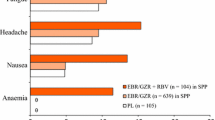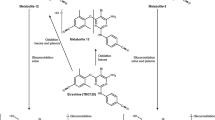Abstract
A 48-year-old Caucasian male patient presented with severe adverse drug events (ADEs) while being treated with a standard dose (600 mg/day) of efavirenz. The patient’s clinical course was favourable; however, he also described intense nightmares, cramps in his legs and anxiety disturbances that made him highly irritable. Measurement of the patient’s efavirenz plasma concentrations revealed a mean minimum steady-state concentration during a dosage interval (Cmin,ss) of 12.7 mg/L, which was much higher than that recommended for this drug (therapeutic range 1–4 mg/L). Consequently, the dose of efavirenz was reduced to 400 mg/day, which resulted in a decrease in the frequency of ADEs. Subsequent genotype testing showed that the patient was homozygous for both the CYP2B6- G516T (T/T) and CYP2B6- A785G (G/G) alleles; these polymorphisms are associated with reduced enzymatic activity and elevated efavirenz plasma concentrations. Because of this and the fact that the patient’s mean efavirenz Cmin,ss was still high (4.6 mg/L), a second dosage reduction was undertaken, to 200 mg/day. This also resulted in a reduction in ADEs. At present, the patient’s CD4+ levels remain stable, his viral load continues to be undetectable and the mean efavirenz Cmin,ss is within the therapeutic range (2.7 mg/L).



Similar content being viewed by others
References
Department of Health and Human Services. Panel on Antiretroviral Guidelines for Adults and Adolescents. Guidelines for the use of antiretroviral agents in HIV-1-infected adults and adolescents. Department of Health and Human Services. 2008 Jan 29: 1-128 [online]. Available from URL: http://www.aidsinfo.nih.gov/ContentFiles/AdultandAdolescentGL.pdf [Accessed 2009 Jul 26]
Blanch J, Martinez E, Rousaud A, et al. Preliminary data of a prospective study on neuropsychiatric side effects after initiation of efavirenz. J Acquir Immune Defic Syndr 2001 Aug 1; 27(4): 336–43
Puzantian T. Central nervous system adverse effects with efavirenz: case report and review. Pharmacotherapy 2002 Jul; 22(7): 930–3
U.S. Food and Drug Administration. Sustiva label information, approved 2008 Aug 18 [online]. Available from URL: http://www.fda.gov/cder/foi/label/2008/020972s030,021360s019lbl.pdf [Accessed 2009 Jul 15]
Staszewski S, Morales-Ramirez J, Tashima KT, et al. Efavirenz plus zidovudine and lamivudine, efavirenz plus indinavir, and indinavir plus zidovudine and lamivudine in the treatment of HIV-1 infection in adults. Study 006 Team. N Engl J Med 1999 Dec 16; 341(25): 1865–73
Fumaz CR, Muñoz-Moreno JA, Moltó J, et al. Long-term neuropsychiatric disorders on efavirenz-based approaches: quality of life, psychologic issues, and adherence. J Acquir Immune Defic Syndr 2005 Apr 15; 38(5): 560–5
Marzolini C, Telenti A, Decosterd LA, et al. Efavirenz plasma levels can predict treatment failure and central nervous system side effects in HIV-1 infected patients. AIDS 2001 Jan 5; 15(1): 71–5
Hasse B, Gunthard HF, Bleiber G, et al. Efavirenz intoxication due to slow hepatic metabolism. Clin Infect Dis 2005Feb1; 40(3): e22–3
Núñez M, González de Requeda D, Gallego L, et al. Higher efavirenz plasma levels correlate with development of insomnia. J Acquir Immune Defic Syndr 2001 Dec 1; 28(4): 399–400
King J, Aberg JA. Clinical impact of patient population differences and genomic variation in efavirenz therapy. AIDS 2008 Sep 12; 22(14): 1709–17
Takahashi M, Ibe S, Kudaka Y, et al. No observable correlation between central nervous system side effects and EFV plasma concentrations in Japanese HIV type 1-infected patients treated with EFV containing HAART. AIDS Res Hum Retroviruses 2007 Aug; 23(8): 983–7
HIV-Pharmacogenomics [online]. Available from URL: http://www.hiv-pharmacogenomics.org [Accessed 2009 Jul 23]
Csajka C, Marzolini C, Fattinger K, et al. Population pharmacokinetics and effects of efavirenz in patients with human immunodeficiency virus infection. Clin Pharmacol Ther 2003 Jan; 73(1): 20–30
Pfister M, Labbe L, Hammer SM, et al. Population pharmacokinetics and pharmacodynamics of efavirenz, nelfinavir and indinavir. Adult AIDS Clinical Trial Group Study 398. Antimicrob Agents Chemother 2003 Jan; 47(1): 130–7
Kappelhoff BS, van Leth F, MacGregor TR, et al. Nevirapine and efavirenz pharmacokinetics and covariate analysis in the 2NN study. Antivir Ther 2005; 10(1): 145–55
Burger D, Van der Heiden I, La Porte C, et al. Interpatient variability in the pharmacokinetics of the HIV non-nucleoside reverse transcriptase inhibitor efavirenz: the effect of gender, race, and CYP2B6 polymorphism. Br J Clin Pharmacol 2006 Feb; 61(2): 148–54
Arab-Alameddine M, Di Iulio J, Buclin T, et al. Pharmacogenetics-based population pharmacokinetic analysis of efavirenz in HIV-1-infected individuals. Swiss HIV Cohort Study. Clin Pharmacol Ther 2009 May; 85(5): 485–94
Cabrera S, Santos D, Valverde MP, et al. Influence of the cytochrome P450 2B6 genotype on population pharmacokinetics of efavirenz in human immunodeficiency virus patients. Antimicrob Agents Chemother 2009 Jul; 53(7): 2791–8
Tsuchiya K, Gatanaga H, Tachikawa N, et al. Homozygous CYP2B6 *6 (Q172H and K262R) correlates with high plasma efavirenz concentrations in HIV-1 patients treated with standard efavirenz-containing regimens. Biochem Biophys Res Commun 2004 Jul 9; 319(4): 1322–6
Haas DW, Ribaudo HJ, Kim RB, et al. Pharmacogenetics of efavirenz and central nervous system side effects: an Adult AIDS Clinical Trials Group study. AIDS 2004 Dec 3; 18(18): 2391–400
Rotger M, Colombo S, Furrer H, et al., Swiss HIV Cohort Study. Influence of CYP2B6 polymorphism on plasma and intracellular concentrations and toxicity of efavirenz and nevirapine in HIV-infected patients. Pharmacogenet Genomics 2005 Jan; 15(1): 1–5
Gatanaga H, Hayashida T, Tsuchiya K, et al. Successful efavirenz dose reduction in HIV type 1-infected individuals with cytochrome P450 2B6 *6 and *26. Clin Infect Dis 2007 Nov 1; 45(9): 1230–7
Gallego L, Barreiro P, del Río R, et al. Analyzing sleep abnormalities in HIV-infected patients treated with efavirenz. Clin Infect Dis 2004 Feb 1; 38(3): 430–2
Buysse DJ, Reynolds CF, Monk TH, et al. The Pittsburgh Sleep Quality Index: a new instrument for psychiatric practice and research. Psychiatry Res 1989 May; 28(2): 193–213
Herrmann C. International experiences with the Hospital Anxiety and Depression Scale: a review of validation data and clinical results. J Psychosom Res 1997 Jan; 42(1): 17–41
Knobel H, Alonso J, Casado JL, et al., GEEMA Study Group. Validation of a simplified medication adherence questionnaire in a large cohort of HIV-infected patients: the GEEMA Study. AIDS 2002 Mar 8; 16(4): 605–13
Institut d’Investigacions Biomédiques August Pi i Sunyer, Institut Clínic de Medicina i Dermatología. Interacciones HIV [online]. Available from URL: http://www.interaccioneshiv.com [Accessed 2009 Jul 25]
Torno MS, Witt MD, Saitoh A, et al. Successful use of reduced-dose efavirenz in a patient with human immunodeficiency virus infection: case report and review of the literature. Pharmacotherapy 2008 Jun; 28(6): 782–7
Rodriguez-Novoa S, Barreiro P, Rendón A, et al. Influence of 516G>T polymorphisms at the gene encoding the CYP450-2B6 isoenzyme on efavirenz plasma concentrations in HIV-infected subjects. Clin Infect Dis 2005 May 1; 40(9): 1358–61
Ribaudo HJ, Haas DW, Tierney C, et al. Pharmacogenetics of plasma efavirenz exposure after treatment discontinuation: an Adult AIDS Clinical Trials Group Study. Clin Infect Dis 2006 Feb 1; 42(3): 401–7
Nolan D, Phillips E, Mallal S. Efavirenz and CYP2B6 polymorphism: implications for drug toxicity and resistance. Clin Infect Dis 2006 Feb 1; 42(3): 408–10
Nyakutira C, Röshammar D, Chigutsa E, et al. High prevalence of the CYP2B6 516G->T (*6) variant and effect on the population pharmacokinetics of efavirenz in HIV/ AIDS outpatients in Zimbabwe. Eur J Clin Pharmacol 2008 Apr; 64(4): 357–65
Fuertes A, Cabrera SE, Valverde MP, et al. Hyperhidrosis in association with efavirenz. AIDS Patient Care STDs 2009 Mar; 23(3): 143–5
Cabrera SE, Valverde MP, Garcïa MJ, et al. Pharmaceutical intervention in the follow-up of antiretroviral therapy. An R Acad Nac Farm 2009; 75(1): 43–62
Pereira SA, Branco T, Caixas U, et al. Intra-individual variability in efavirenz plasma concentrations supports therapeutic drug monitoring based on quarterly sampling in the first year of therapy. Ther Drug Monit 2008 Feb; 30(1): 60–6
Cabrera SE, Cordero M, Iglesias A, et al. Efavirenz-rifampicin interaction: therapeutic drug monitoring to efavirenz dosage optimization in HIV/TBC patients. AIDS 2008 Nov 30; 22(18): 2549–51
ConsejoGeneral de Colegios Oficiales de Farmcëuticos. BOT-Plus [cd-rom]. Ver. 4.4.0. Madrid: 2009
Acknowledgements
This case report was supported by funding granted by the project FIS PI070714, the Ministry of Health and Consumption of Spain, in the frame of the National Plan of I+D+I 2004–2007. The authors’ work was independent of the funding body. All authors made substantial contributions to the work and meet the criteria for authorship. The authors have no conflicts of interest that are directly relevant to the content of this report.
Author information
Authors and Affiliations
Corresponding author
Rights and permissions
About this article
Cite this article
Figueroa, S.C., Gómez, A.I., Martín, A.S. et al. Long-Term Efficacy and Safety of Efavirenz Dose Reduction to 200 mg Once Daily in a Caucasian Patient with HIV. Clin. Drug Investig. 30, 405–411 (2010). https://doi.org/10.1007/BF03256910
Published:
Issue Date:
DOI: https://doi.org/10.1007/BF03256910




